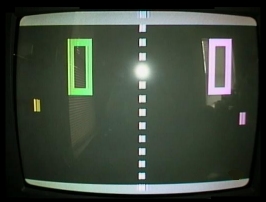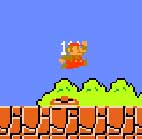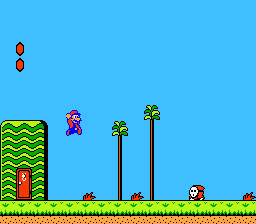
Videogame Physics:
Introduction
Early Video Game Physics
Modern Video Game Physics
Dynamic Objects
Ragdoll Physics
Physics Hall of Shame
Bibliography/Links

Early Videogame Physics
World-Class High Jump Plumbers
In the beginning, there was Pong. Well, that's not actually true, as there were a fair number of other games before Pong, but ask just about anyone what the first video game was and they'll answer Pong.
Pong is less like Ping Pong, and more like Air Hockey. A single ball slides over a frictionless surface, doomed to bounce between two paddles and two walls locked in a struggle for domination until one of them misses.

Picture from Pong-Story Webpage. Game depicted is Pong by Atari.
In truth, physics principles didn't factor a lot into Pong's design. The ball always travels with the same constant velocity. When the ball hits a wall, it simply travels on the negative of its current slope. The flat paddles actually act more like curved ones, reflecting the ball at much lower angles towards the ends. All of these approximations of real physics were made because:
A) Computing physics is expensive, and processors were pretty pitiful when Pong was created. Therefore the simpler the better.
B) Realistic physics probably wouldn't have been as fun.
These two principles continue to guide the use of physics in games today. The key is to simulate as little as you can get away with, and never sacrifice playability and fun factor for realism. What's the point of playing a video game if the character or objects on-screen can't do anything more exciting then what you can? You might as well just go outside and play on the playground! And what kind of self-respecting child would want to go outside to play?! The horror!
Well, a few years later(about 20 years in fact), Nintendo released Maro Bros. Here we have a much more realistic world, with a human character that you can make jump around the screen. Mario is a great example of how realism can and should be chucked out the window whilst designing games. Let's look at a few ways Mario is unrealistic and how this works to make the game more fun:

A quick diagram I whipped up depicting Mario's grotesque inhuman jumping ability. Screenshots were taken by me while playing Nintendo's Mario Bros. game.
Mario can jump incredibly high. 5 times his own height, in fact. Either the gravity in Mario land is extremely low, or Mario's stubby little legs are extremely powerful. The world record high jump for men in 1993 was done by Javier Sotomayer of Cuba(according to University of Exeter's Centre for Innovation in Mathematics Teaching), who reached a high of 2.45m. Javier was 6'5", or 1.96m. This means he jumped 1.25 times his own height. Thus, if Mario has the same jumping capability as Javier, then the gravity in Mario land must be 1/4(1.25/5) that of Earth's(9.8 m/s^2).
For comparison, the gravity on the moon is about 1.67m/s^2. Of course, assuming a chubby plumber has the same jumping capability as a world-class athlete may be a stretch. Thus, Mario Land gravity may be closer to moon gravity. Either way, it's a lot lower than Earth's. But does it matter? Mario's huge leaps make the game loads more fun.

Screenshot were taken by me while playing Nintendo's Mario Bros. game.
Perhaps you haven't noticed, but Mario KILLS THINGS BY JUMPING ON THEM. He squishes them until they default and CEASE TO EXIST. If I were to, say, jump onto a badger and squish it to death, people would be horrified. They would be even more horrified if the badger then disappeared completely. The closest you could get would be to squish the badger until it turned into dust and then blow it away. That would be hard.
Squishing things that are about the same size as you isn't easy because of Newton's Third Law, which states that for as much force you exert on something, it exerts the same amount back on you. You have to be able to dish out the hurt AND take it. Thus squishing something larger isn't easy. Sure, Goombas are probably pretty squishy creatures(hollow on the inside with thin walls), but it would still be difficult.
But ultimately, squishing something provides the player with the perverse satisfaction that they have eradicated completely one of their enemies. Therefore, it is fun, if not entirely(or at all) realistic.

Screenshot from Nintendo's Mario Brothers 2, from Pilze-Wunderland's Mario page.
Starting with Mario Bros. 2, things got even less realistic. In Mario 1, you were at least subject to the constraint that once you jumped, you may be able to slow down the horizontal velocity of your jump a bit, but you still are committed to that direction. From Mario Bros. 2 on, Mario is free to change directions mid-jump. I don't know if you've ever tried to change directions mid-jump, but it's not easy. Impossible even. This is due to conservation of momentum.
You cannot 'lose' momentum in one direction while jumping unless a counterbalance momentum is gained in the other direction so that the total momentum is conserved. Thus, if Mario had some puppies in his pants(don't really want to think about why), he could toss the puppies in the direction of his jump to fly backwards. Of course, having Mario throwing puppies out of his pants would be stupid.
Changing direction mid-jump is great because it doesn't penalize players for making the wrong jumping decision. If you jump towards an enemy then realize you're not going to hit him right, you can correct your course. This makes the game feel a lot freer, and was a good decision to make. In fact playing Mario Bros. 1 'feels' a bit odd to many gamers used to being able to change direction mid-jump.
Hopefully these examples have made you realize that realism doesn't always make a game more fun. For a look at how modern games have used realistic physics to make games more immersive, have a look at the Modern Game Physics section.